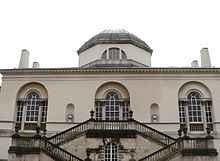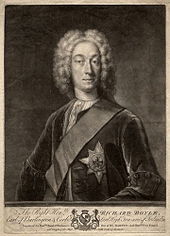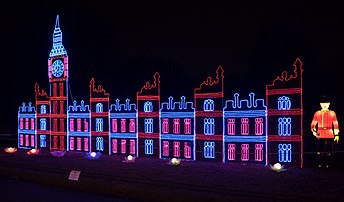Chiswick House
| Chiswick House | |
|---|---|
Neo-Palladian | |
| Location | Chiswick, London, England |
| Coordinates | 51°29′02″N 0°15′31″W / 51.48376°N 0.25866°W |
| Completed | 1729 |
| Owner | English Heritage |
| Design and construction | |
| Architect(s) | Richard Boyle, 3rd Earl of Burlington |
| Website | |
| chiswickhouseandgardens | |
Chiswick House is a
After the death of the 3rd Earl of Burlington in 1753, and the subsequent deaths of his last surviving daughter (Charlotte Boyle) in 1754 and his widow in 1758, the property was ceded to William Cavendish, 4th Duke of Devonshire, Charlotte's husband. After William's death in 1764, the villa passed to his and Charlotte's orphaned young son, William Cavendish, 5th Duke of Devonshire. His wife, Georgiana Spencer, a prominent and controversial figure in fashion and politics whom he married in 1774, used the house as a retreat and as a Whig stronghold for many years; it was where Charles James Fox died in 1806. Prime Minister George Canning also died there in 1827, in a bedroom in the John White wing buildings.
During the 19th century, the house fell into decline and was rented out by the Cavendish family. It was used as a mental hospital, the
History
Early history (c.1610–1682)
The original Chiswick House was a
Boyle family (1682–1758)

The Jacobean house was used by the Boyle family as a summer retreat from their central London home, Burlington House.[9][10] After a fire in 1725, Richard Boyle, 3rd Earl of Burlington (Lord Burlington), then head of the family,[9] decided to build a new "villa" to the west of the old Chiswick House.
During his trip to Italy in 1719, Burlington had acquired a passion for Palladian architecture.
Burlington, himself a talented amateur architect and (in the words of Horace Walpole) "Apollo of the Arts",[15] designed the villa with the aid of William Kent, who also took a leading role in designing the gardens.[16] Burlington built the villa with enough space to house his art collection, regarded as containing "some of the best pictures in Europe",[17] and his more select pieces of furniture, some of which was purchased on his first Grand Tour of Europe in 1714. Construction of the villa took place between 1726 and 1729.[18]
After Burlington's death in 1753,
Cavendish family (1758–1929)

After the death of Lady Burlington in 1758, the villa and gardens passed to the Cavendish family. William Cavendish died in 1764, leaving the property to his son William, the 5th
In 1813, a 300 feet (91 m) conservatory was built by Samuel Ware, with the purpose of housing exotic fruits and camellias.[30] > Gardener Lewis Kennedy built an Italian inspired geometric garden around the conservatory. In 1827, after a rapid decline in health, Tory Prime Minister George Canning died in the same room where Charles James Fox had died in 1806.[31]

Between 1862 and 1892 the villa was rented by the Cavendish family to a number of successive tenants, including the Duchess of Sutherland in 1867,[32] the Prince of Wales in the 1870s,[33] and John Crichton-Stuart, 3rd Marquess of Bute, patron of the architect William Burges, from 1881 to 1892.[34]
Chiswick Asylum (1892–1928)
From 1892, the 9th Duke of Devonshire rented the villa to Doctors Thomas Seymour and Charles Molesworth Tuke (sons of Thomas Harrington Tuke), and it was used by them as a mental hospital, the Chiswick Asylum, for wealthy male and female patients until 1928.[35] The asylum was praised for its relatively compassionate approach to its inmates. The wings of the house used for the asylum were demolished in the 1950s so little now remains of this use, except in archival records.[36] In 1897, the two sphinxes on the main gate were removed to Green Park during the celebrations of Queen Victoria's Diamond Jubilee. They were never returned.[37]
Public ownership (1929–present)

The 9th Duke of Devonshire sold Chiswick House to Middlesex County Council in 1929,
In 1948, extensive lobbying from the newly created
Hounslow Council and English Heritage formed the Chiswick House and Gardens Trust in 2005 to unify the management of the villa and gardens. The trust took over the administration for the villa and gardens in July 2010, following the completion of the restoration works.[43] A Heritage Lottery Fund Grant was complemented by approximately £4 million from other sources, for restoration of the gardens in 2007.[38] The garden is open to the public from dawn until dusk without charge.[44]
Villa building

Chiswick House was an attempt by Lord Burlington to create a
Burlington's use of Roman sources can also be seen in the steep-pitched dome of the villa, which is derived from the Pantheon in Rome. However, the source for the octagonal form of the dome, the Upper Tribunal, Lower Tribunal and cellar at Chiswick may be Vincenzo Scamozzi's Rocca Pisana near Vicenza.[53] Burlington may also have been influenced in his choice of octagon by the drawings of the Renaissance architect Sebastiano Serlio (1475–1554),[54] or by Roman buildings of antiquity (for example, Lord Burlington owned Andrea Palladio's drawings of the octagonal mausoleum at Diocletian's Palace, Split in modern Croatia).[55]

The brick-built Villa's facade is faced in
On the portico leading to the Domed Hall is positioned a bust of the Roman

At the rear of the villa were positioned '
The house when built was described by
Gardens

The gardens at Chiswick were an attempt to recreate a garden of ancient Rome,
A lake was created around 1727 by widening the
The kitchen garden was founded in 1682. Its ownership changed several times, and the garden fell into disrepair. In 2005 it was restored by local volunteers of the Chiswick House Kitchen Garden Community project. In 2009 the kitchen garden was taken over by Chiswick House and Gardens Trust; the National Lottery Heritage Fund provided a grant for restoration work and the conversion of the surrounding buildings.[67]
Freemasonry

Chiswick House has been linked with
Notable guests
Although little is known of the people who stayed or visited the house in Lord Burlington's lifetime, many important visitors to the property are recorded as visiting throughout its history. These included leading figures of the European '
On 20 May 1966, the
Events
Since the restoration of the gardens, a variety of seasonal events have been held in the gardens of Chiswick House each year, including a Camellia show, open days in the walled kitchen garden, a circus, and a magic lantern festival.[77][78]
-
Sculpture of the Palace of Westminster at a magic lantern festival in the gardens
-
Artisan food market
Notes
- ^ The statues have been attributed to John Michael Rysbrack (1694–1770), but the attribution has been challenged by Richard Hewlings. See Richard Hewlings, "The Statues of Inigo Jones and Palladio at Chiswick House" in English Heritage Historical Review, Volume 2, 2007, 71–83.
References
- ^ "Chiswick House and Gardens". English Heritage. Retrieved 25 January 2018.
- ^ "Chiswick House, Hounslow, England". Parks & Gardens UK. Parks and Gardens Data Services. 27 July 2007. Archived from the original on 4 March 2016. Retrieved 18 April 2014.
- ^ a b Lancaster, Henry (2010). "Wardour, Sir Edward (1578–1646), of Chiswick House, Chiswick, Mdx. and St. Martin-in-the-Fields, Westminster". The History of Parliament.
- ^ a b "Chiswick House". Current Archaeology (222). 1 September 2008.
- ^ Brayley, Edward Wedlake; Brewer, James Norris; Nightingale, Joseph (1816). London and Middlesex. Vol. 4. Vernor, Hood, and Sharpe. p. 315.
- ^ "The Estates Around Chiswick House". Brentford and Chiswick Local History Society. 1997.
- ^ "The Battle of Turnham Green". Chiswick W4. 19 November 2004. Archived from the original on 16 February 2018.
- ISBN 978-1136429651.
- ^ a b Furniture History Society (1986). Furniture history. p. 84.
- ISBN 9781857590135.
- ISBN 978-0-313-32426-0.
- ISBN 978-0-7112-2769-9.
- ISBN 978-88-8118-524-5.
- ISBN 978-1-905711-24-6.
- ^ Wilton-Ely, John (1973). Apollo of the arts: Lord Burlington and his circle. Nottingham University Art Gallery. p. 31.
- ^ Groves & Mawrey 2010, p. 68.
- ^ Bryan, Julius (1993). London's Country House Collections. Kenwood, Chiswick, Marble Hill, Ranger's House. London: Scala Publications for English Heritage. p. 36.
- ^ Randhawa, Kiran (19 December 2007). "Chiswick House set for £12m facelift". Evening Standard. London. Archived from the original on 5 May 2013.
- ISBN 9781871647747.
- ISBN 978-0-688-00432-3.
- ^ Journal of the Derbyshire Archaeological and Natural History Society. Derbyshire Archaeological Society. 1903. p. 130.
- ISBN 978-0-7734-8367-5.
- doi:10.1080/01445170.1987.10412457. See the article on John Donowellfor a selection of the views.
- ^ Lodge, Edmund (1867). The peerage and baronetage of the British Empire as at present existing. Hurst and Blackett. p. 179.
- ISBN 978-0-7914-6146-4.
- ^ Foreman, Amanda (2001). Georgiana's World. The Illustrated Georgiana, Duchess of Devonshire. HarperCollins. p. 182.
- ^ Choice. American Library Association. 2000.
- ^ Jullian, Philippe (1967). Edward and the Edwardians. Viking Press.
- ^ ISBN 978-1-4050-4924-5.
- ^ Groves & Mawrey 2010, p. 78.
- ^ England (1840). The Parliamentary Gazetteer of England and Wales. 4 volumes bound in 12 parts with supplements. p. 442.
- ISBN 978-0197227565.
- ^ Country Life. Country Life. 1979.
- ^ Hewlings 1989, pp. 52–53.
- ^ ISBN 978-0-333-32556-8.
- ^ "History of Place: Chiswick Asylum". Retrieved 5 January 2022.
- ^ a b "The Restoration of Chiswick House Gardens". London Garden Trust. Retrieved 7 May 2011.
- ^ a b Groves & Mawrey 2010, p. 79.
- ISBN 9780070210981.
- ISBN 978-0-520-22795-8.
- ISBN 978-1-85698-006-7.
- ISBN 978-0-313-31850-4.
- ^ "Unveiling of the Restored Chiswick House Gardens" (PDF). Chiswick House and Gardens Trust. Archived from the original (PDF) on 5 October 2011. Retrieved 7 May 2011.
- ^ "Visitor information". Chiswick House and Gardens Trust. Retrieved 7 May 2011.
- ISBN 978-1852850944.
- ^ Yarwood, Doreen (1970). Robert Adam. Scribner. p. 104.
- ISBN 9780750923248.
- ISBN 978-1-85285-177-4.
- ISBN 978-0-8160-5335-3.
- ^ The Architects' Journal. The Architectural Press. 1990.
- ^ ISBN 978-0-7892-0252-9.
- ^ New Statesman Society. Statesman & Nation. 1995. p. 93.
- ISBN 978-88-8118-524-5.
- ISBN 978-0-8122-3457-2.
- ISBN 978-0-09-460310-3.
- ^ Coleridge, Samuel Taylor (1845). Encyclopaedia Metropolitana: Difform-Falter. B. Fellowes. p. 397.
- ISBN 978-0-300-05983-0.
- ^ James Stevens Curl, The Egyptian Revival. Ancient Egypt as the Inspiration for Design Motifs in the West (Abingdon, Routledge, 2005) 22–30.
- ^ Bryant, Julius. Villa Views and the Uninvited Audience in Arnold, Dana (eds.), The Georgian Villa. Allan Sutton Publishing Limited, 1996, p23
- ISBN 978-1857590135.
- OCLC 1156718283.
- ISBN 978-0521105798.
- JSTOR 1586331.
- ^ Hewlings 1989, p. 25.
- ^ John Harris and Gordon Higgott, Inigo Jones. Complete Architectural Drawings (London: Zwemmer, 1989) pp. 128–131.
- ^ Hewlings 1989, p. 53.
- ^ "The Kitchen Garden". Chiswick House & Gardens Trust. Archived from the original on 7 December 2021. Retrieved 2 April 2024.
- ^ ISBN 978-0-19-927439-0.
- ^ Groves & Mawrey 2010, p. 75.
- ^ Pound, Ricky, "Chiswick House-a Masonic Temple?", in Gillian Clegg (eds.), Brentford & Chiswick Local History Journal, Number 16, 2007,4–7
- ^ Pound, Ricky, "The Master Mason Slain: the Hiramic Legend in the Red Velvet Room at Chiswick House", in Richard Hewlings (eds.), "English Heritage Historical Review", Volume 4, 2009, 154–163
- ^ Carre, Jaques. Lord Burlington's Book Subscriptions. in Corp, Edward. Lord Burlington. The Man and his Politics. The Edward Mellen Press, 1998, p126
- ISBN 978-0-7506-2267-7.
- ISBN 978-0-7141-2765-1.
- ^ a b "History of Chiswick House". Chiswick House and Gardens Trust. Archived from the original on 19 October 2014.
- ^ "The Beatles". Chiswick House and Gardens Trust.
- ^ "What's On". Chiswick House & Gardens Trust. Archived from the original on 11 May 2017. Retrieved 21 March 2017.
- ^ Ellis, David (16 January 2017). "Magical Lantern Festival at Chiswick House: stunning displays light up grounds for Chinese New Year". Evening Standard.
Further reading
- Bibliography
- Groves, Linden; Mawrey, Gillian (24 August 2010). The Gardens of English Heritage. ISBN 978-0-7112-2771-2.
- Barnard, Toby & Clark, Jane (eds.), Lord Burlington. Architecture, Art and Life, (London: The Hambledon Press, 1995)
- Clegg, Gillian, Chiswick House and Gardens: A History, (London: McHugh Publications, 2011)
- Harris, John, The Palladian Revival: Lord Burlington, His Villa and Garden at Chiswick, (New Haven: Yale University Press, 1994)
- Hewlings, Richard (1989). Chiswick House and Gardens (guidebook). English Heritage.
- Jacques, David (2022). Chiswick House Gardens. Swindon: ISBN 978-1-80085-621-9.
- White, Roger, Chiswick House and Gardens, (English Heritage guide book, 2001)
- Periodicals
- Bryant, Julius, "Chiswick House-the inside story. Policies and problems of restoration", in Apollo magazine, CXXXVI, 1992, 17–22
- Cornforth, John, "Chiswick House, London", in Country Life, 16 February 1995, 32–37
- Fellows, David, "This old house. Excavations at Chiswick House", in Current Archaeology, Number 223, October 2008, 20–29
- Hewlings, Richard, "Palladio in England. Chiswick House, London", in Country Life, 28 January 2009, 46–51
- Hewlings, Richard, "The Statues of Inigo Jones and Palladio at Chiswick House", in English Heritage Historical Review, Volume 2, 2007, 71–83
- Hewlings, Richard, "The Link Room at Chiswick House. Lord Burlington as antiquarian", in Apollo magazine, CXLI, 1995, 28–29
- Kingsbury, Pamela D., "The Tradition of the Soffitto Veneziano in Lord Burlington's Suburban Villa in Chiswick", in Architectural History, Volume 44, 2001, 145–152
- Rosoman, Treve, "The Decoration and Use of the Principal Apartments of Chiswick House, 1727–70", in The Burlington Magazine, Volume 127, Number 991, October 1985, 663–677
- Spence, R.T, "Chiswick House and its gardens", in The Burlington Magazine, Volume 135, Number 1085, August 1993, 525–531
- Scanlan, Matthew, "A Masonic Temple in West London?", in Freemasonry Today, Winter 2006/7, Issue 39, 32–34
- Carre, Jacques, "Lord Burlington's Garden at Chiswick", in Garden History, Volume 1, Number 3, Summer 1973, 23–30
- Clegg, Gillian, "The Duke of Devonshire's Menagerie at Chiswick House", in Richard Hewlings (eds.) English Heritage Historical Review, Volume 3, 2008, 123–127
- Harris, John, "Is Chiswick a 'Palladian' Garden?", in Garden History, Volume 32, No.1, Spring 2004, 124–136
- Jacques, David, "What to Do about Earlier Inaccurate Restoration: A Case Study of Chiswick House", in APT Bulletin, Volume 24, Number 3/4, Conserving Historic Landscapes, 1992, 4–13
- Sicca, Cinzia Maria, "Lord Burlington at Chiswick: Architecture and Landscape", in Garden History, Volume 10, Number 1, Spring 1982, 36–69



